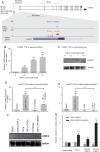Identification of TNF-α-responsive promoters and enhancers in the intestinal epithelial cell model Caco-2
- PMID: 24990076
- PMCID: PMC4263293
- DOI: 10.1093/dnares/dsu022
Identification of TNF-α-responsive promoters and enhancers in the intestinal epithelial cell model Caco-2
Abstract
The Caco-2 cell line is one of the most important in vitro models for enterocytes, and is used to study drug absorption and disease, including inflammatory bowel disease and cancer. In order to use the model optimally, it is necessary to map its functional entities. In this study, we have generated genome-wide maps of active transcription start sites (TSSs), and active enhancers in Caco-2 cells with or without tumour necrosis factor (TNF)-α stimulation to mimic an inflammatory state. We found 520 promoters that significantly changed their usage level upon TNF-α stimulation; of these, 52% are not annotated. A subset of these has the potential to confer change in protein function due to protein domain exclusion. Moreover, we locate 890 transcribed enhancer candidates, where ∼50% are changing in usage after TNF-α stimulation. These enhancers share motif enrichments with similarly responding gene promoters. As a case example, we characterize an enhancer regulating the laminin-5 γ2-chain (LAMC2) gene by nuclear factor (NF)-κB binding. This report is the first to present comprehensive TSS and enhancer maps over Caco-2 cells, and highlights many novel inflammation-specific promoters and enhancers.
Keywords: alternative promoters; inflammation; non-coding RNAs; transcribed enhancers; transcriptional regulation.
© The Author 2014. Published by Oxford University Press on behalf of Kazusa DNA Research Institute.
Figures





Similar articles
-
Regulation of Laminin γ2 Expression by CDX2 in Colonic Epithelial Cells Is Impaired During Active Inflammation.J Cell Biochem. 2017 Feb;118(2):298-307. doi: 10.1002/jcb.25636. Epub 2016 Jun 29. J Cell Biochem. 2017. PMID: 27333824
-
A novel NF-kappa B/Rel site in intron 1 cooperates with proximal promoter elements to mediate TNF-alpha-induced transcription of the human polymeric Ig receptor.J Immunol. 2001 Dec 1;167(11):6412-20. doi: 10.4049/jimmunol.167.11.6412. J Immunol. 2001. PMID: 11714807
-
Iron Prevents Hypoxia-Associated Inflammation Through the Regulation of Nuclear Factor-κB in the Intestinal Epithelium.Cell Mol Gastroenterol Hepatol. 2019;7(2):339-355. doi: 10.1016/j.jcmgh.2018.10.006. Epub 2018 Oct 17. Cell Mol Gastroenterol Hepatol. 2019. PMID: 30704983 Free PMC article. Clinical Trial.
-
Molecular mechanism of tumor necrosis factor-alpha modulation of intestinal epithelial tight junction barrier.Am J Physiol Gastrointest Liver Physiol. 2006 Mar;290(3):G496-504. doi: 10.1152/ajpgi.00318.2005. Am J Physiol Gastrointest Liver Physiol. 2006. PMID: 16474009
-
Induction of neutrophil gelatinase-associated lipocalin expression by co-stimulation with interleukin-17 and tumor necrosis factor-alpha is controlled by IkappaB-zeta but neither by C/EBP-beta nor C/EBP-delta.J Biol Chem. 2010 May 7;285(19):14088-100. doi: 10.1074/jbc.M109.017129. Epub 2010 Mar 10. J Biol Chem. 2010. PMID: 20220144 Free PMC article.
Cited by
-
Comprehensive profiling of the fission yeast transcription start site activity during stress and media response.Nucleic Acids Res. 2019 Feb 28;47(4):1671-1691. doi: 10.1093/nar/gky1227. Nucleic Acids Res. 2019. PMID: 30566651 Free PMC article.
-
The RNA exosome contributes to gene expression regulation during stem cell differentiation.Nucleic Acids Res. 2018 Nov 30;46(21):11502-11513. doi: 10.1093/nar/gky817. Nucleic Acids Res. 2018. PMID: 30212902 Free PMC article.
-
Intestinal regulation of suppression of tumorigenicity 14 (ST14) and serine peptidase inhibitor, Kunitz type -1 (SPINT1) by transcription factor CDX2.Sci Rep. 2018 Aug 7;8(1):11813. doi: 10.1038/s41598-018-30216-z. Sci Rep. 2018. PMID: 30087389 Free PMC article.
-
The RNA exosome shapes the expression of key protein-coding genes.Nucleic Acids Res. 2020 Sep 4;48(15):8509-8528. doi: 10.1093/nar/gkaa594. Nucleic Acids Res. 2020. PMID: 32710631 Free PMC article.
-
Characterization of the enhancer and promoter landscape of inflammatory bowel disease from human colon biopsies.Nat Commun. 2018 Apr 25;9(1):1661. doi: 10.1038/s41467-018-03766-z. Nat Commun. 2018. PMID: 29695774 Free PMC article.
References
-
- Koch S., Nusrat A. The life and death of epithelia during inflammation: lessons learned from the gut. Annu. Rev. Pathol. 2012;7:35–60. - PubMed
-
- Ordás I., Mould D.R., Feagan B.G., Sandborn W.J. Anti-TNF monoclonal antibodies in inflammatory bowel disease: pharmacokinetics-based dosing paradigms. Clin. Pharmacol. Ther. 2012;91:635–46. - PubMed
-
- Nielsen O.H., Ainsworth M.A. Tumor necrosis factor inhibitors for inflammatory bowel disease. N. Engl. J. Med. 2013;369:754–62. - PubMed
-
- Hidalgo I.J., Raub T.J., Borchardt R.T. Characterization of the human colon carcinoma cell line (Caco-2) as a model system for intestinal epithelial permeability. Gastroenterology. 1989;96:736–49. - PubMed
Publication types
MeSH terms
Substances
LinkOut - more resources
Full Text Sources
Other Literature Sources
Molecular Biology Databases
Research Materials

